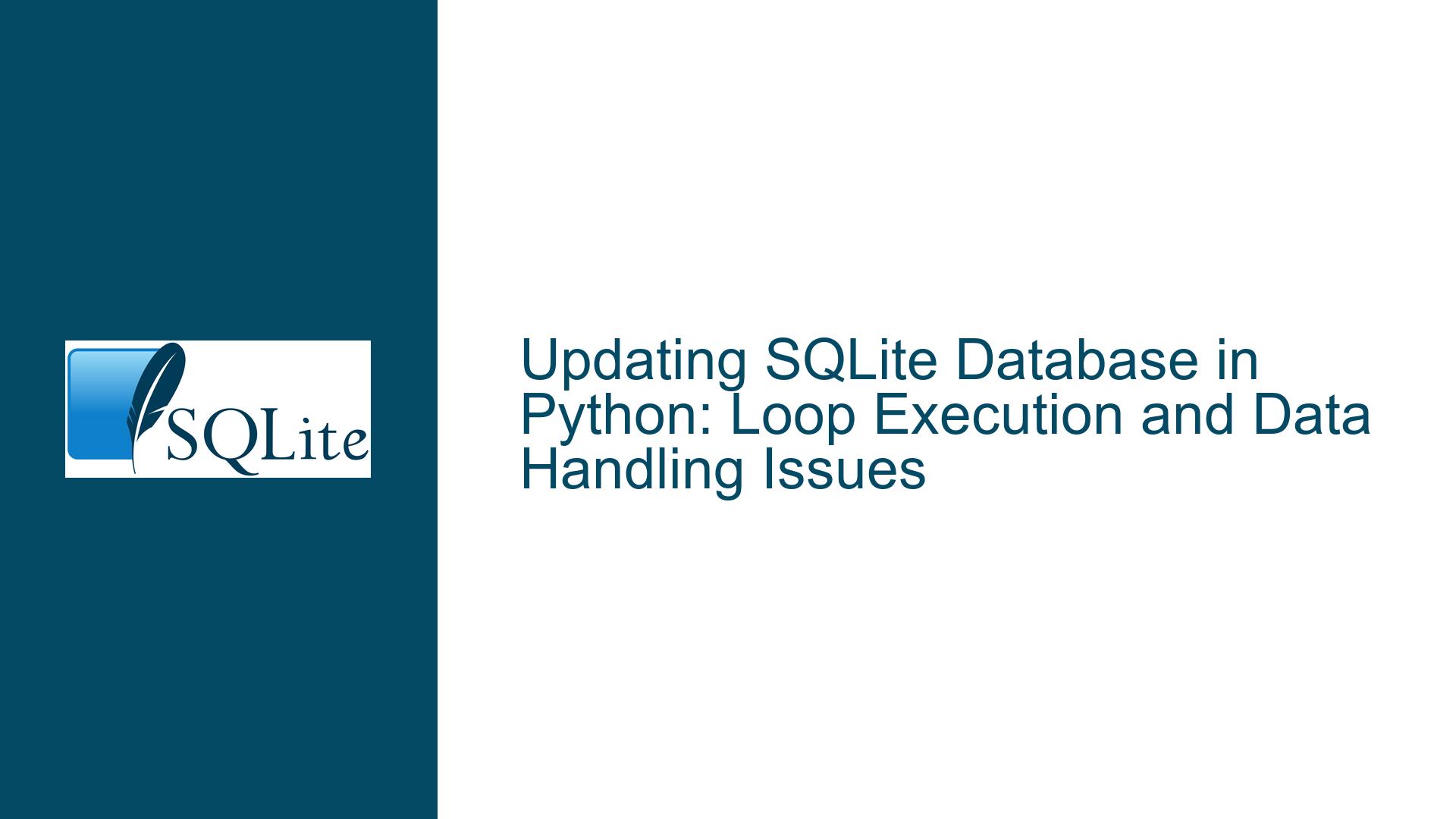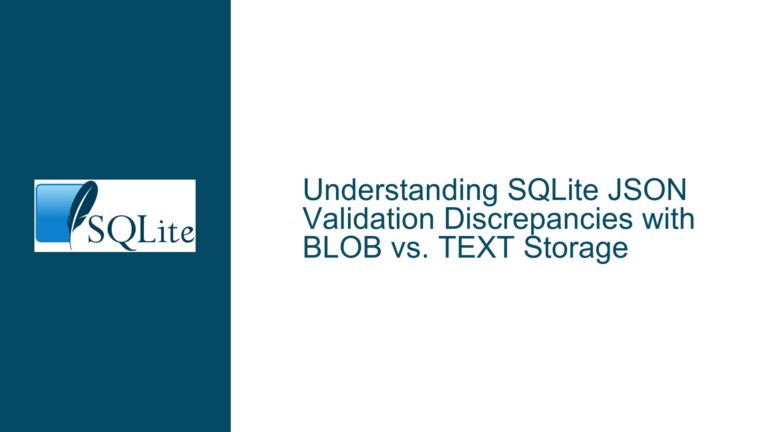Updating SQLite Database in Python: Loop Execution and Data Handling Issues
Issue Overview: Updating SQLite Database Within a SELECT Loop in Python
When working with SQLite databases in Python, a common task involves reading data from a table and updating it within the same loop. However, this seemingly straightforward operation can lead to unexpected behavior, such as the loop executing only once or failing to handle complex data types correctly. The core issue arises from the interaction between the SELECT and UPDATE operations on the same table within a single connection and cursor. This interaction can disrupt the cursor’s state, causing the loop to terminate prematurely.
Additionally, the handling of complex data types, such as text containing spaces, single/double quotes, and carriage returns, introduces another layer of complexity. While SQLite’s parameterized queries (using the ? placeholder) are designed to handle such data safely, understanding their limitations and proper usage is crucial to avoid errors.
The problem is further compounded by SQLite’s transactional model, which differs from client-server databases. SQLite’s lightweight nature means that it lacks certain features, such as UPDATE ... WHERE CURRENT OF cursor, which are available in other relational databases. This necessitates alternative approaches to achieve the desired functionality.
Possible Causes: Cursor State Disruption and Transaction Management
The primary cause of the loop executing only once is the disruption of the cursor’s state due to the UPDATE operation within the SELECT loop. When a SELECT query is executed, the cursor iterates over the result set. However, if an UPDATE operation modifies the same table being read, it can invalidate the cursor’s position, causing the loop to terminate prematurely. This behavior is a direct consequence of SQLite’s isolation model, which only guarantees isolation between different connections, not within the same connection.
Another contributing factor is the automatic transaction management in SQLite. By default, SQLite starts a transaction automatically when a modification operation (like UPDATE) is executed and commits it when the operation completes. This automatic behavior can interfere with the intended flow of operations, especially when multiple modifications are performed within a loop. Manually managing transactions by setting isolation_level=None and explicitly starting and committing transactions can provide better control over the process.
The handling of complex data types, such as text with special characters, is generally well-managed by SQLite’s parameterized queries. However, improper usage or misunderstandings about how these placeholders work can lead to errors. The ? placeholder in SQLite’s parameterized queries is designed to safely handle various data types, including text with spaces, quotes, and carriage returns. Ensuring that the data is correctly bound to the placeholder is essential to avoid issues.
Troubleshooting Steps, Solutions & Fixes: Effective Strategies for Updating SQLite Databases in Python
To address the issue of the loop executing only once, several strategies can be employed. The first approach involves fetching all the rows from the SELECT query before performing any updates. This ensures that the cursor’s state is not disrupted by the UPDATE operations. Here’s how this can be implemented:
import sqlite3
# Connect to the SQLite database
con = sqlite3.connect("test.sqlite", isolation_level=None)
con.row_factory = sqlite3.Row
cur = con.cursor()
# Fetch all rows before performing updates
cur.execute("BEGIN IMMEDIATE")
rows = cur.execute("SELECT content.id AS id, basic, full FROM content, users WHERE content.created_by=users.id").fetchall()
for row in rows:
try:
# Perform the update operation
cur.execute("UPDATE content SET basic2=? WHERE id=?", (newstuff, row["id"]))
except sqlite3.Error:
print("Update failed!")
cur.execute("ROLLBACK")
raise StopIteration # Stop the loop after a rollback
# Commit the transaction
cur.execute("COMMIT")
# Close the cursor and connection
cur.close()
con.close()
In this approach, the fetchall() method retrieves all the rows from the SELECT query before the loop begins. This ensures that the cursor’s state remains consistent throughout the loop, preventing premature termination.
Another effective strategy involves using a second connection and cursor for the UPDATE operations. This approach leverages SQLite’s isolation between connections to avoid disrupting the SELECT cursor’s state. Here’s how this can be implemented:
import sqlite3
# Connect to the SQLite database with two separate connections
con = sqlite3.connect("test.sqlite")
con.row_factory = sqlite3.Row
cur = con.cursor()
con2 = sqlite3.connect("test.sqlite", isolation_level=None)
con2.row_factory = sqlite3.Row
cur2 = con2.cursor()
# Begin a transaction on the second connection
cur2.execute("BEGIN")
# Perform the SELECT operation on the first connection
for row in cur.execute("SELECT content.id AS id, basic, full FROM content, users WHERE content.created_by=users.id"):
try:
# Perform the update operation on the second connection
cur2.execute("UPDATE content SET basic2=? WHERE id=?", (newstuff, row["id"]))
except sqlite3.Error:
print("Update failed!")
cur2.execute("ROLLBACK")
break # Stop the loop after a rollback
# Commit the transaction on the second connection
cur2.execute("COMMIT")
# Close the cursors and connections
cur2.close()
con2.close()
cur.close()
con.close()
In this approach, the SELECT operation is performed on the first connection (con), while the UPDATE operation is performed on the second connection (con2). This separation ensures that the UPDATE operations do not interfere with the SELECT cursor’s state.
To handle complex data types safely, it is essential to use parameterized queries correctly. The ? placeholder in SQLite’s parameterized queries is designed to handle various data types, including text with spaces, quotes, and carriage returns. Here’s an example of how to safely bind complex data to a parameterized query:
import sqlite3
# Connect to the SQLite database
con = sqlite3.connect("test.sqlite", isolation_level=None)
con.row_factory = sqlite3.Row
cur = con.cursor()
# Example of complex data
newstuff = "This is a complex text with 'single quotes', \"double quotes\", and carriage returns.\n"
# Fetch all rows before performing updates
cur.execute("BEGIN IMMEDIATE")
rows = cur.execute("SELECT content.id AS id, basic, full FROM content, users WHERE content.created_by=users.id").fetchall()
for row in rows:
try:
# Perform the update operation with complex data
cur.execute("UPDATE content SET basic2=? WHERE id=?", (newstuff, row["id"]))
except sqlite3.Error:
print("Update failed!")
cur.execute("ROLLBACK")
raise StopIteration # Stop the loop after a rollback
# Commit the transaction
cur.execute("COMMIT")
# Close the cursor and connection
cur.close()
con.close()
In this example, the newstuff variable contains complex text with spaces, single/double quotes, and carriage returns. The ? placeholder in the UPDATE query safely handles this data, ensuring that it is correctly inserted into the database without causing errors.
In conclusion, updating an SQLite database within a SELECT loop in Python requires careful consideration of cursor state management, transaction handling, and data type handling. By fetching all rows before performing updates, using a second connection for updates, and correctly using parameterized queries, you can avoid common pitfalls and ensure that your database operations execute as intended. These strategies provide a robust foundation for working with SQLite databases in Python, enabling you to handle complex scenarios with confidence.






